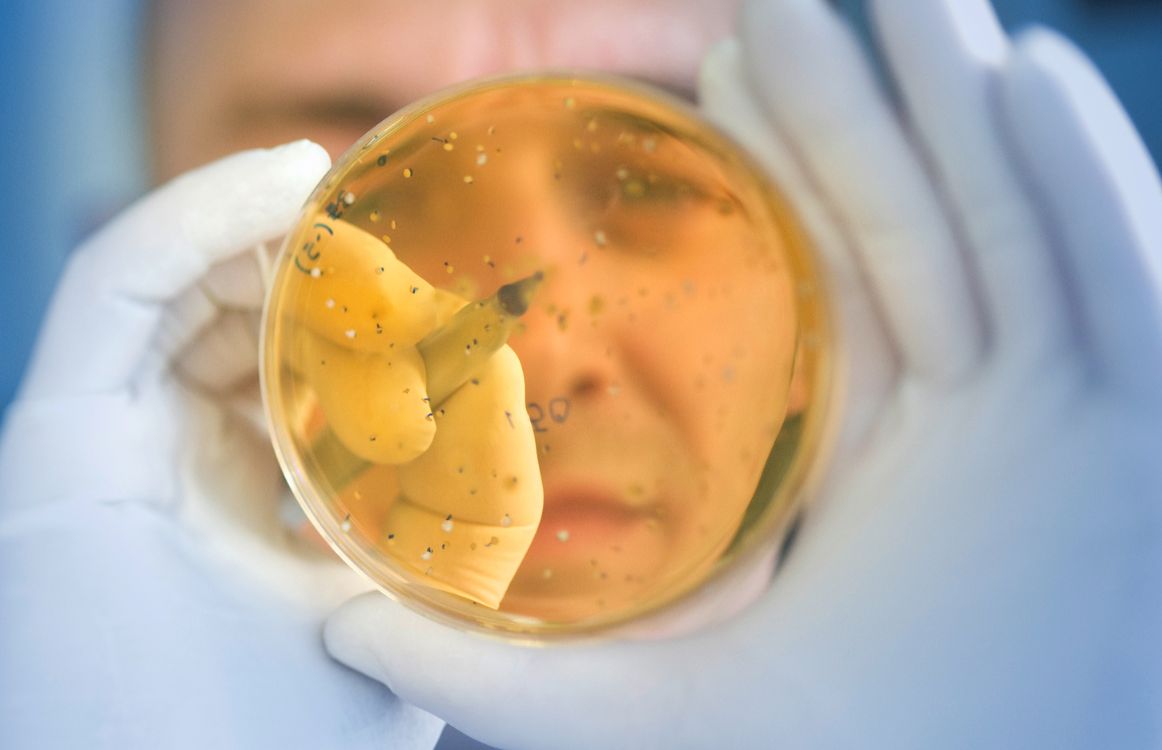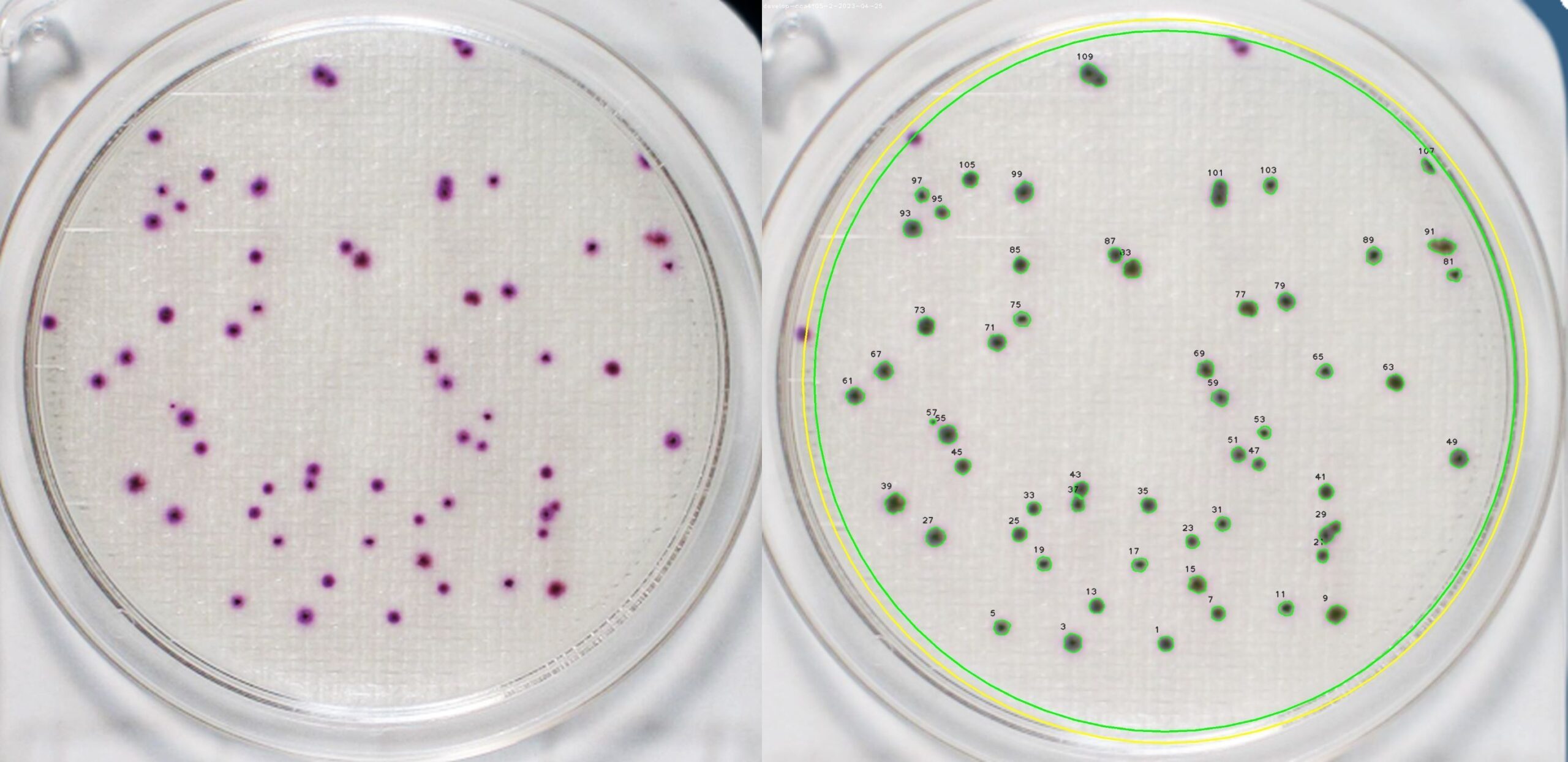How to Count Bacterial Colonies on Agar Plate

There is one simple and yet incredibly complex approach to understanding how to count bacterial colonies on agar plate. You simply mark the visible colonies with a marker on the underside of the petri dish. So simple, right? But wait. When you look a little deeper, it gets much more complicated.
Download here for free our comprehensive PDF Guide (19 pages) on How to Count Colonies on Agar Plates!
The Function of the Agar Plate
First, we must understand the function of the agar plate. Agar plate, or petri dishes with an agar medium culture inside, are the universally accepted standard for watching bacteria grow.
Agar is a gelatin made from red algae that will stay in place and hold any bacteria you add to it in place as well. It is resistant to cold and will hold up well at room temperature, so you don’t have to worry about it falling apart while you perform your experiment.
Unlike gelatin, it is made from clean plants, so you don’t have to be concerned with animal products interfering with the culture.
Types of Agar Media
Depending on the type of bacteria you are growing, you can choose from among different agar media. The most common in basic bacteria growth is nutrient agar, which provides basic nutrients for the bacteria to feed on and grow.
To make the many various agar media, agar is mixed with a culture and then poured into the petri dish.
For some, blood agar is necessary, as in the case of more fastidious organisms. For others, chocolate agar may be essential to monitor the growth of respiratory bacteria.
MacConkey agar is used for the growth of gram-negative bacteria and Neomycin agar is used to for anaerobic growth.
There is a wide variety of cultures mixed with agar in order to properly grow specific bacteria. It is up to each scientist to pick which agar works for you.
Why We Count Bacterial Colonies
In general, we count bacterial colonies so that we can measure how much bacteria exists in a particular sample. It could be a matter of checking contamination of water, checking the toxins in food, or even monitoring the health of a person’s blood or other biological processes.
We count bacterial colonies for so many reasons.
We start with figuring out how much bacteria may be in a particular sample. Then, we can begin to address how to treat the bacteria, if that is what is called for, and how strong we want the concentration of that treatment to be.
How to Prepare an Agar Plate
For this reason, we must be sure we prepare the agar plate correctly. There is so much room for human error, that it is essential to cover all of our bases, step-by-step.
The first and most important thing to do is make sure to dilute the sample. A count of higher than 250 CFUs is considered too large to accurately comprehend. In general, a bacterial sample should be diluted at least twice, and you can do this with a 1:10 ratio of sample to sterile water.
Once diluted, you want to ensure you have chosen the correct agar culture medium for your bacteria. Sometimes it is a guessing game, but you can review the literature on what you hypothesize will show up in your sample and then use the agar culture best suited to your hypothesis.
Again, in general, you can always fall back on agar nutrient.
Then, using a cotton swab, dip it into the sample and swipe the swab back and forth across the agar in a tight zig-zag motion. Rotate the plate 90 degrees and perform the same swiping motion. Rotate once more and perform the same swiping motion. Make sure you swipe from end to end and get the entire edge of the agar medium.
Now, you can place the lid on the petri dish, flip it upside down, and place it in your incubator at whatever temperature your potential bacteria calls for.
After 24 hours, you can begin your count.
How to Count Bacterial Colonies on Agar Plate
To count bacterial colonies on agar plate, remove the petri dish from the incubator, take a black marker, and mark the bottom of the dish wherever you see a colony forming unit (CFU).
Of course, you may find the colonies are too small, too close to each other, or too numerous to accurately count.
This is where an automated colony counter comes in handy.

Consider a Colony Counter
Many microbiologists are now turning to image recognition software to perform the colony count for them, and it makes sense.
By eliminating human error, you are able save time, energy, and money in an already laborious process. You also stand to do more good in the world by accurately counting bacterial colonies to better understand and treat them.
Oculyze has designed a Colony Counter that requires only an uploaded image of a Petri Dish. The app can then return an accurate colony count you can record in your notes.
With the Oculyze Colony Counter you can trust that the part of the process most subject to human error has been streamlined and safeguarded.
Summing It All Up
In the end, while colony counting itself seems easy (mark the petri dish with a black marker), the reality is much more complicated. Colonies can be too small, too numerous, and overlapping in ways that make it difficult for the human eye to pick up on and the human brain to register or understand.
Employing a colony counter to do the work for you saves time, energy, and money, and allows you to continue the important work you do without fear of recording errors. Ask your agar plate manufacturer about the possibility of implementing this technology.
Are you an agar plate manufacturer / distributor? Enhance your product offering by providing your customers with an automated analysis for pre-poured agar plates, which eliminates the need for laborious manual counting! The Automated Counter developed by Oculyze can count colonies with high accuracy and speed, using only an uploaded image of a Petri dish.
Test our Colony Counter! Completely free of charge and with no commitment to purchase. Just please note that the recognition provided here is solely for demonstration purposes and may not accurately represent the performance of our product. Our customers receive customized recognitions tailored to their specific needs, which ensures high levels of accuracy for their plates.
Let artificial intelligence do the hard work for your customers. Want to know more? Contact us and we’ll be happy to help!


